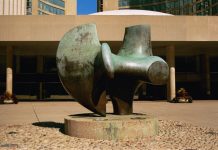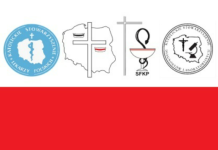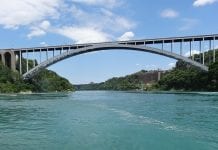Według najnowszych doniesień prasowych prowincji Nowa Fundlandia i Labrador zagląda w oczy bankructwo.
Istnieje wiele tego przyczyn typowych wynikających z polityki prowincji. Politycy nienawidzą obniżać wydatki, uwielbiają obniżać podatki i nienawidzą je zwiększać, ponieważ boją się reakcji wyborców. Politycy nie są liderami, lecz niewolnikami trendów.
– pisze w poniższym tekście Eamonn Brosnan pracownik naukowy Frontier Center for Public Policy .
Manage provincial debt by controlling Crown projects
In Newfoundland and several other provinces, major power projects have created huge public debt
By Eamon Brosnan
Research Associate
Frontier Centre for Public Policy
 The province of Newfoundland and Labrador is staring bankruptcy in the eye, according to recent news reports.
The province of Newfoundland and Labrador is staring bankruptcy in the eye, according to recent news reports.
There are a variety of reasons, which are typical for provincial politics. Politicians hate to cut services, love to cut taxes and hate to increase taxes because voters react to all of those things. Politicians aren’t leaders, they’re followers of trends.
Newfoundland has a few disadvantages that make running a government challenging.
With 521,542 people over 405,212 square km, that’s easily the lowest population density among Canada’s provinces (the territories are more sparse). That makes delivering services – education, transportation, communication or health care – more expensive.
With only seven members of Parliament, the province has very little influence when it comes time for negotiations on the national scale.
Historically, the province relied on a single industry – fishing – and that collapsed nearly 30 years ago, leading to decade-long historic unemployment levels.
The province has since diversified. But now it receives a sizable portion of its revenues from the oil and gas industry. That leaves it susceptible to the wild swings of oil’s boom and bust cycles.
These factors have combined to make Newfoundland’s per capita provincial debt the highest of all of Canada’s provinces.
Newfoundland has paid down some of its debt in the last decade and hasn’t received net payments from the federal equalization program during that period.
However, a single source is threatening to push the province’s finances over the brink. The ill-fated Muskrat Falls hydroelectricity project, combined with a power link from Labrador to the island of Newfoundland, have increased the province’s liabilities by almost 50 per cent.
These projects are under the control of Nalcor, Newfoundland’s Crown energy corporation. It manages Newfoundland’s hydro projects, as well as the province’s stake in its offshore oil industry.
The combined projects were initially estimated to cost $6.2 billion. But ineptitude, inaccurate estimating and a lack of control have ballooned that to an estimated $12.7 billion. And the projects’ estimated operating costs for the next 45 years appear to have increased as well.
This debt is beyond Nalcor’s ability to finance from existing revenue. The alternative is to increase the cost of electricity to the average homeowner dramatically. Electricity costs could jump from 13 cents a kilowatt hour (kWh) to 78 cents.
With the new funding framework in place, rates would only increase slightly – except that the funding framework has a $4.8-billion gap that federal and provincial representatives have waved at, suggesting they would work it out in the details.
The province hopes the federal government can help with costs, even if the federal government isn’t eager to commit more money to bailing out the province. If the gap doesn’t get funded, households will see their rates first jump from 13 cents to an estimated 23 cents.
Three other provinces are dealing with severe cost overruns at large power projects: B.C.’s Site C dam, Manitoba’s Keeyask dam and Ontario’s nuclear reactor refurbishments.
In some situations, Crown power companies have been accruing substantial debt that has been kept off the government’s books. That has allowed politicians to curry favour with voters by keeping electricity rates artificially low.
Other Crown power corporations have significant debt:
-
BC Hydro is at $20 billion;
-
SaskPower is at $7.2 billion;
-
Manitoba Hydro is at $19 billion;
-
Hydro-Quebec is at $45.8 billion;
-
NB Power is at $5.3 billion.
Crown corporations should be independent and free from political interference. But instead they’ve been abused by political leaders to boost re-election chances. That results in capital projects that make no fiscal sense, pricing that’s too low to cover the costs of delivering the services, and obfuscation of the books to hide the debt that we’ve accumulated.
The result?
Mammoth liabilities that put the fiscal stability of provincial governments at risk.
Should the federal government come to Newfoundland’s aid?
I can’t see how the province can stabilize its books and grow without assistance. But advancing aid to Newfoundland will mean the federal government will have to deal with similar issues in a number of other provinces.
Perhaps now is the time to review how provinces have handled their Crown corporations and institute review boards free of political interference. The Muskrat Falls project should never have received approval, for example.
Should the federal government help stabilize provincial liabilities?
Not doing so risks higher servicing costs for public debt on already strained budgets. Provincial debt ratings are helped by the fact they’re within the larger framework of a strong country. Stepping in and helping balance the books of provinces could help those governments become stronger and more prosperous, benefiting the entire country.
But this can only happen if the provinces can guarantee that the same mistakes won’t be made again. And for that we need project review boards that operate independent of any party in power.
Eamonn Brosnan is a research associate with the Frontier Centre for Public Policy.
The views, opinions and positions expressed by all Troy Media columnists and contributors are the author’s alone. They do not inherently or expressly reflect the views, opinions and/or positions of Troy Media.
































































.gif)







